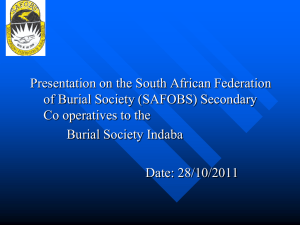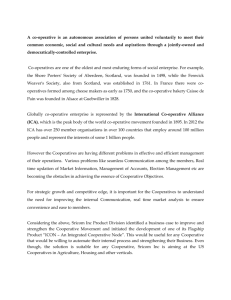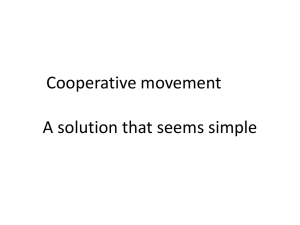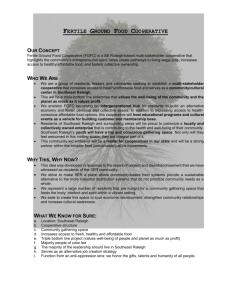ABM 2203 COOPERATIVES AND AGRIBUSINESS
advertisement
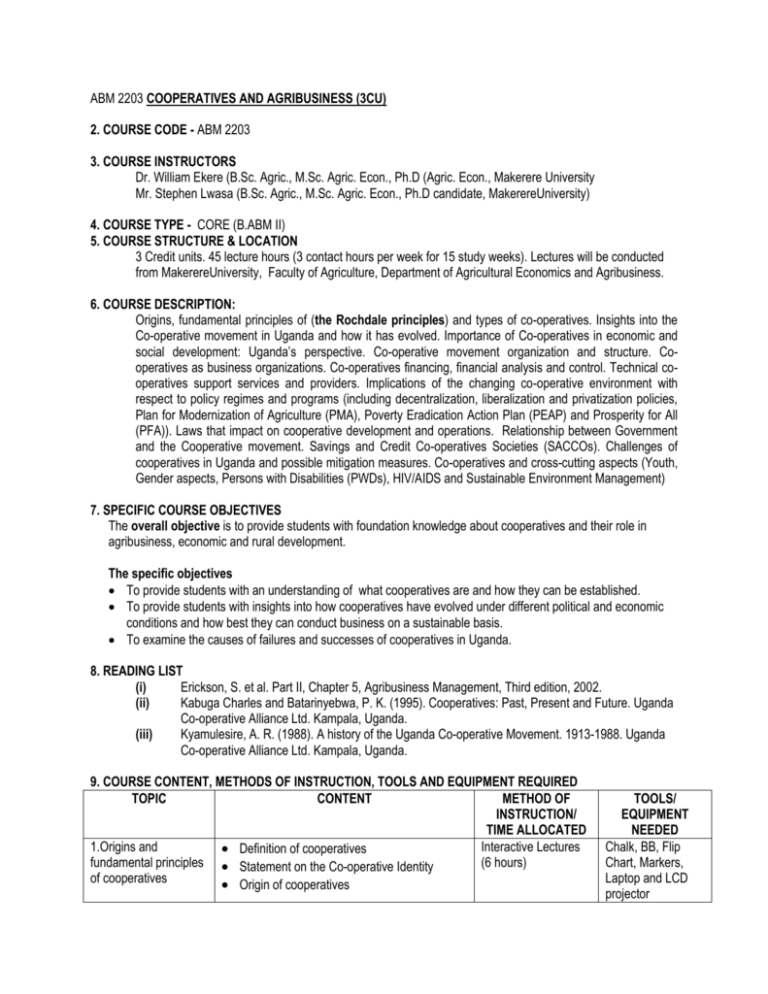
ABM 2203 COOPERATIVES AND AGRIBUSINESS (3CU) 2. COURSE CODE - ABM 2203 3. COURSE INSTRUCTORS Dr. William Ekere (B.Sc. Agric., M.Sc. Agric. Econ., Ph.D (Agric. Econ., Makerere University Mr. Stephen Lwasa (B.Sc. Agric., M.Sc. Agric. Econ., Ph.D candidate, MakerereUniversity) 4. COURSE TYPE - CORE (B.ABM II) 5. COURSE STRUCTURE & LOCATION 3 Credit units. 45 lecture hours (3 contact hours per week for 15 study weeks). Lectures will be conducted from MakerereUniversity, Faculty of Agriculture, Department of Agricultural Economics and Agribusiness. 6. COURSE DESCRIPTION: Origins, fundamental principles of (the Rochdale principles) and types of co-operatives. Insights into the Co-operative movement in Uganda and how it has evolved. Importance of Co-operatives in economic and social development: Uganda’s perspective. Co-operative movement organization and structure. Cooperatives as business organizations. Co-operatives financing, financial analysis and control. Technical cooperatives support services and providers. Implications of the changing co-operative environment with respect to policy regimes and programs (including decentralization, liberalization and privatization policies, Plan for Modernization of Agriculture (PMA), Poverty Eradication Action Plan (PEAP) and Prosperity for All (PFA)). Laws that impact on cooperative development and operations. Relationship between Government and the Cooperative movement. Savings and Credit Co-operatives Societies (SACCOs). Challenges of cooperatives in Uganda and possible mitigation measures. Co-operatives and cross-cutting aspects (Youth, Gender aspects, Persons with Disabilities (PWDs), HIV/AIDS and Sustainable Environment Management) 7. SPECIFIC COURSE OBJECTIVES The overall objective is to provide students with foundation knowledge about cooperatives and their role in agribusiness, economic and rural development. The specific objectives To provide students with an understanding of what cooperatives are and how they can be established. To provide students with insights into how cooperatives have evolved under different political and economic conditions and how best they can conduct business on a sustainable basis. To examine the causes of failures and successes of cooperatives in Uganda. 8. READING LIST (i) Erickson, S. et al. Part II, Chapter 5, Agribusiness Management, Third edition, 2002. (ii) Kabuga Charles and Batarinyebwa, P. K. (1995). Cooperatives: Past, Present and Future. Uganda Co-operative Alliance Ltd. Kampala, Uganda. (iii) Kyamulesire, A. R. (1988). A history of the Uganda Co-operative Movement. 1913-1988. Uganda Co-operative Alliance Ltd. Kampala, Uganda. 9. COURSE CONTENT, METHODS OF INSTRUCTION, TOOLS AND EQUIPMENT REQUIRED TOPIC CONTENT METHOD OF INSTRUCTION/ TIME ALLOCATED 1.Origins and Interactive Lectures Definition of cooperatives fundamental principles Statement on the Co-operative Identity (6 hours) of cooperatives Origin of cooperatives TOOLS/ EQUIPMENT NEEDED Chalk, BB, Flip Chart, Markers, Laptop and LCD projector 2. Types of cooperatives 3. Evolution of the Cooperative movement in Uganda 4. Importance of Cooperatives in economic and social development The Rochdale principles Origins of the Cooperatives in Uganda Types of cooperatives Forms of Co-operative federations Introduction to modern cooperatives Interactive Lectures (2 hours) Tutorials and assignment (1 hour) to cover topics 1 & 2. Chalk, BB, Flip Chart, Markers, Laptop and LCD projector Formative years Rapid Cooperative expansion era Post independence era Post independence era The Period of Political instability Pre-liberalization era Post-liberalization era A historical perspective cooperative benefits Benefits of cooperatives: Empirical evidence from Uganda Interactive Lectures (2 hours) Chalk, BB, Flip Chart, Markers, Laptop and LCD projector Interactive Lectures (2 hours) Chalk, BB, Flip Chart, Markers, Laptop and LCD projector Excursion: Topic: empirical evidence of impact of cooperatives on society (2 hours) 80 seater bus Diesel (150 litres) TOPIC 5. Co-operative movement organization and structure CONTENT 6. Co-operatives as business organizations 7. Co-operatives financing, financial analysis and control METHOD OF INSTRUCTION/ TIME ALLOCATED Interactive Lectures The tiers (legal entities) of the old (2 hours) cooperative structure. Causes for the collapse of the Cooperative Unions The underlying need for a new cooperative structure The new cooperative structure Interactive Lectures Structure of Business enterprises (2 hours) Cooperative business objectives Comparison between cooperatives and other Tutorials (1 hour) to cover topics 3-6 business organizations Steps in establishment of Cooperatives Management of Cooperatives Interactive Lectures Cooperatives financing sources (2 hours) Financial analysis and control Financial performance indicators TOOLS/ EQUIPMENT NEEDED Chalk, BB, Flip Chart, Markers, Laptop and LCD projector Chalk, BB, Flip Chart, Markers, Laptop and LCD projector Chalk, BB, Flip Chart, Markers, Laptop and LCD projector 8. Technical cooperatives support services and providers Technical services required for vibrant Interactive Lectures 9. Implications of the changing co-operative environment with respect to policy regimes and programs Reasons for accepting restructuring and Interactive Lectures (2 hours) cooperatives Institutions that offer directly and indirect services to cooperatives in Uganda implementation of various programs Globalization Liberalization Privatization Poverty Eradication Action Plan Plan for Modernization of Agriculture The Strategic Exports Programme The Rural Development Strategy Medium Term Competitiveness Strategy Zoning initiatives Ware House Receipt System TOPIC CONTENT (2 hours) METHOD OF INSTRUCTION/ TIME ALLOCATED Interactive Lectures (2 hours) Tutorial (1 hour) to cover topics 6-9) 10. Laws that impact on cooperative development and operations Changes in the cooperative regulatory 11. Relations between Government and the Cooperative movement Interactive Lectures The role of government The role of the Ministry of Tourism, Trade (1 hours) 12. Savings and Credit Co-operatives (SACCOs) framework. Impact of the Law on Co-operatives and Industry Functions of the Department of Cooperative Development Definition, organization and management of 13. Challenges of cooperatives in Uganda and possible mitigation measures SACCOs Management and Organizational Structure of SACCOs Impact of SACCOS on Rural Communities Role in mobilizing financial resources for rural development. Uganda Cooperative Savings and Credit Union Challenges of Cooperatives at the Cooperative Level. Challenges of Cooperatives in the MacroEconomic Context: What needs to be done to improve Cooperative Operations Guest speaker from the Ministry of Tourism, Trade and Industry (2 hours. Interactive Lectures (2 hours) Excursion: Formation, operations, benefits, sustainability and challenges of SACCOs (2 hours) Interactive Lectures (2 hours) Chalk, BB, Flip Chart, Markers, Laptop and LCD projector Chalk, BB, Flip Chart, Markers, Laptop and LCD projector TOOLS/ EQUIPMENT NEEDED Chalk, BB, Flip Chart, Markers, Laptop and LCD projector Chalk, BB, Flip Chart, Markers, Laptop and LCD projector Chalk, BB, Flip Chart, Markers, Laptop and LCD projector 80 seater bus Diesel (150 litres) Chalk, BB, Flip Chart, Markers, Laptop and LCD projector 14. Co-operatives and cross-cutting aspects Cooperatives and the youth, gender and Persons with Disabilities (PWDs) Cooperatives and HIV/AIDS Cooperative and environmental sustainability. Interactive Lectures (2 hours) CONTENT METHOD OF INSTRUCTION/ TIME ALLOCATED Guest speaker from Uganda Cooperative Alliance (2 hours) TOPIC 15. Empirical overview of cooperatives 16-17 Challenges Success stories Sustainability of cooperatives Proposed way forward Revision Time Final Examination 10. SUMMARY OF TIME NEEDED Lectures Tutorials (and assignments) Excursions Guest speakers Tutorial to cover and assignment (topics 10 -13) (1 hour) Chalk, BB, Flip Chart, Markers, Laptop and LCD projector TOOLS/ EQUIPMENT NEEDED Chalk, BB, Flip Chart, Markers, Laptop and LCD projector Tutorial to cover (topics 14 -15) 32 hrs 5 hrs 4 hrs 4 hrs 11. COURSE ASSESSMENT: Continuous assessment There will be 2 quizzes during week 4 and 13 of the semester (Quizzes): Continuous assessment A 2 hour test will be given during week 9 of the semester (Test): University Examination: Final examination during week 16-17 of the semester 20% 20% 60%


